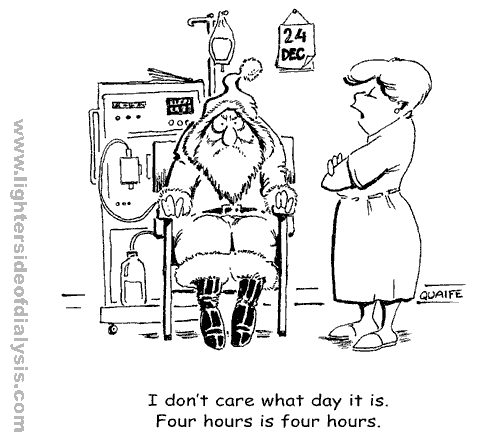This is a short introduction. Further information, including videos and leaflets, is available from Renal Units. In Edinburgh, the Community Dialysis Team keeps this information.
See also the Further Information section at the foot of this page.
How does it work?
During haemodialysis the blood is treated by passing it through an artificial kidney.
Plastic tubes connect you to the dialysis machine and, in order to provide a good blood flow, a fistula, or neckline, or other device will be necessary.
Most patients will have a fistula constructed in the arm and this will require a brief admission to hospital. It is not usually a major procedure. It will be done under a general or local anaesthetic and the staff will explain the procedure to you.
Whilst your fistula is developing, it may be necessary to place a temporary plastic tube in one of the blood vessels in your neck. This temporary measure will allow you to have dialysis until your fistula is ready for use. These tubes are not as good as a fistula because they may become blocked or infected.
Where, when, how long?
Cartoons by Peter Quaife, from The Lighter Side of Dialysis (Jazz Communications), with permission.
Most patients require three sessions a week with each session lasting between three and five hours, depending on your needs.
Dialysis itself is relatively painless, although initially you may feel a bit light-headed at the end of each session. For this reason we ask you not to drive during the first few weeks after coming off treatment.
The amount of dialysis you need is decided according to blood tests taken before and after dialyis. URR and Kt/V are commonly used measurements to decide dialysis length. They aren’t everything though – hours of dialysis are probably also important.
Are problems common?
In general, most patients feel physically better after two or three weeks of treatment but haemodialysis may cause side effects.
Generally speaking, your energy levels may drop a bit as haemodialysis can be a bit tiring, particularly the day after treatment. Take this into account and try not to over-stretch yourself.
It is also important to note that people with kidney failure are more prone to infection. Any sign of infection such as sore throats, boils or fever, should be reported to the Unit staff.
Simple measures such as maintaining good personal hygiene and eating sensibly within the guidelines go a long way to helping you feel well.
On the whole, once you are established on treatment, you should feel quite an improvement in your overall health.
What about my diet on haemodialysis?
Diet is important for patients on dialysis. More information about diet on haemodialysis.
Home haemodialysis
After a spell, consideration may be given to a home dialysis installation. Home dialysis gives you much more freedom and independence, and makes it possible to consider more frequent or longer dialysis, which often makes you feel much better. Should this be decided upon, the hospital make all the arrangements and meet the costs. A “helper”, usually a spouse, partner or relative, will be taught how to assist you.
 Further information
Further information
| ESRF (End stage renal failure) | The EdRenINFO page on treatments for end stage renal failure, with links to other treatment types. |
| Holidays for Haemodialysis patients | Download from EdRenINFO Haemodialysis page. |
| NKF leaflet | The NKF (UK) provides an excellent leaflet on haemodialysis which is reproduced on their website click on ‘Medical Info’. It is the leaflet that we give our patients in Edinburgh. |
| Kidney Patient Guide info | The Kidney Patient Guide website has excellent explanations of dialysis techniques, and particularly good animations of how dialysis works. There is also much other information about life on dialysis. |
| Advanced info on dialysis | The Edren textbook on haemodialysis – is aimed as non-specialist medical staff. |
| Holidays | See the links to some sites on our Other links page – but also read the section in our ESRF pages on How Will Dialysis Affect Me |
Local information
lnitially you will usually be dialysised within the Royal lnfirmary. If you wish, you will be encouraged to become involved in the treatment process. This helps to maintain your independence. Patients are encouraged to make their own arrangements for transport to the dialysis unit but, if necessary, the staff can arrange for you to be brought in by ambulance or ambulance car.
If you live in the Borders, you may, in time, be transferred to the satellite unit at the Borders General Hospital (BGH) which greatly reduces your travelling time. Whatever your treatment, help is available from the Renal Unit in the lnfirmary at all times, day and night, by our fully trained and qualified staff.
Within the lnfirmary and the Western General Hospital (WGH) we operate a three shift system, 6 days per week. There are no sessions on a Saturday. You will be advised whether to attend in the morning, afternoon or evening shift. Every effort will be made to give you a time and to complete your treatment promptly but please remember that delays are sometimes unavoidable, for example when an emergency arises, technical problems crop up or transport difficulties develop. We will try to accommodate you on the shift most suited to you but we would emphasise that the late evening shift is usually reserved for patients who have been stabilised on treatment and this can take a few months.
Acknowledgements: The authors of this page were Richard Dingwall and his colleagues from the Community Dialysis Team. It was first published in January 2001. The date is was last modified is shown in the footer.


